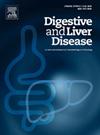使用基于人工智能的CT协议测量脂肪体成分及其与住院患者严重急性胰腺炎的关系
IF 3.8
3区 医学
Q1 GASTROENTEROLOGY & HEPATOLOGY
引用次数: 0
摘要
背景/目的:体成分在预测急性胰腺炎(AP)严重程度方面的临床应用尚不清楚。我们的目的是利用人工智能(AI)测量身体成分来预测住院患者的严重AP。方法:我们对2018年在三家三级医疗中心住院的AP患者进行了回顾性研究。纳入入院时腹部计算机断层扫描(CT)成像的患者。采用全自动、有效的腹部分割算法进行体成分分析。主要结局是严重AP,根据修订的亚特兰大分类定义为持续的单器官或多器官衰竭。结果:共纳入352例患者。严重AP 35例(9.9%)。在多变量分析中,调整男性性别和AP首次发作后,肌间脂肪组织(IMAT)与严重AP相关,OR = 1.06 / 5 cm2, p = 0.0207。皮下脂肪组织(SAT)面积接近显著性,OR = 1.05, p = 0.17。内脏脂肪组织(VAT)和骨骼肌(SM)均与严重AP无关。在未调整的分析中,肥胖患者较高的SM与严重AP相关(中度和轻度分别为86.7 vs 75.1和70.3 cm2, p = 0.009)。结论:在这项使用AI测量身体成分的多位点回顾性研究中,我们发现IMAT升高与严重AP相关。尽管SAT对严重AP不显著,但其接近统计学意义。VAT和SM均不显著。在更大的前瞻性研究中进一步研究可能是有益的。本文章由计算机程序翻译,如有差异,请以英文原文为准。
Measurement of adipose body composition using an artificial intelligence-based CT Protocol and its association with severe acute pancreatitis in hospitalized patients
Background/Objectives
The clinical utility of body composition in predicting the severity of acute pancreatitis (AP) remains unclear. We aimed to measure body composition using artificial intelligence (AI) to predict severe AP in hospitalized patients.
Methods
We performed a retrospective study of patients hospitalized with AP at three tertiary care centers in 2018. Patients with computer tomography (CT) imaging of the abdomen at admission were included. A fully automated and validated abdominal segmentation algorithm was used for body composition analysis. The primary outcome was severe AP, defined as having persistent single- or multi-organ failure as per the revised Atlanta classification.
Results
352 patients were included. Severe AP occurred in 35 patients (9.9%). In multivariable analysis, adjusting for male sex and first episode of AP, intermuscular adipose tissue (IMAT) was associated with severe AP, OR = 1.06 per 5 cm2, p = 0.0207. Subcutaneous adipose tissue (SAT) area approached significance, OR = 1.05, p = 0.17. Neither visceral adipose tissue (VAT) nor skeletal muscle (SM) was associated with severe AP. In obese patients, a higher SM was associated with severe AP in unadjusted analysis (86.7 vs 75.1 and 70.3 cm2 in moderate and mild, respectively p = 0.009).
Conclusion
In this multi-site retrospective study using AI to measure body composition, we found elevated IMAT to be associated with severe AP. Although SAT was non-significant for severe AP, it approached statistical significance. Neither VAT nor SM were significant. Further research in larger prospective studies may be beneficial.
求助全文
通过发布文献求助,成功后即可免费获取论文全文。
去求助
来源期刊

Digestive and Liver Disease
医学-胃肠肝病学
CiteScore
6.10
自引率
2.20%
发文量
632
审稿时长
19 days
期刊介绍:
Digestive and Liver Disease is an international journal of Gastroenterology and Hepatology. It is the official journal of Italian Association for the Study of the Liver (AISF); Italian Association for the Study of the Pancreas (AISP); Italian Association for Digestive Endoscopy (SIED); Italian Association for Hospital Gastroenterologists and Digestive Endoscopists (AIGO); Italian Society of Gastroenterology (SIGE); Italian Society of Pediatric Gastroenterology and Hepatology (SIGENP) and Italian Group for the Study of Inflammatory Bowel Disease (IG-IBD).
Digestive and Liver Disease publishes papers on basic and clinical research in the field of gastroenterology and hepatology.
Contributions consist of:
Original Papers
Correspondence to the Editor
Editorials, Reviews and Special Articles
Progress Reports
Image of the Month
Congress Proceedings
Symposia and Mini-symposia.
 求助内容:
求助内容: 应助结果提醒方式:
应助结果提醒方式:


